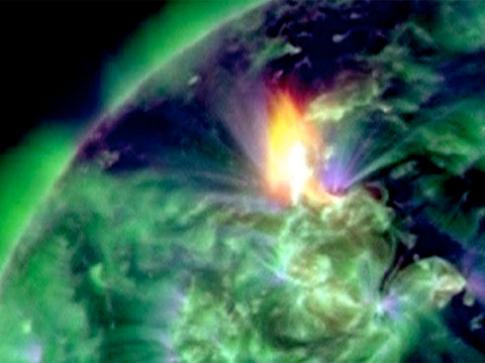Solar Superstorm: UK 'Must Brace For Threat'

A solar superstorm would have proved lethal for the Apollo astronauts had one occurred when they were on the Moon.
Sky News
Britain must do more to prepare for a once-in-a-century "solar superstorm", according to experts.
The Government is being urged by the Royal Academy of Engineering to set up a UK Space Weather Board to help cope with a massive radiation blast from the Sun.
Such an explosion could trigger black-outs, knock out one in 10 satellites, and disrupt aircraft and GPS systems.
Statistically a solar superstorm is likely to occur every 100 to 200 years.
Although solar weather events happen regularly, the Earth has not experienced a superstorm since the start of the space age.
The last true superstorm, known as the Carrington event occurred in 1859, when Earth was hit by a tidal wave of energetic particles following a large solar flare.
Induced currents caused by the blast sent sparks flying from telegraph pylons and caused fires. Around the world, night skies were lit up by magnificent aurora displays.
But at that time there were no satellites in orbit or sensitive microchips in the path of the particles.
Experts now warn that another solar superstorm on the scale of the Carrington event is "inevitable" and Britain should be prepared, although the effects are not expected to be cataclysmic.
Professor Paul Cannon, who chaired the Academy's working group on extreme solar weather, said: "Our message is: don't panic, but do prepare - a solar superstorm will happen one day and we need to be ready for it."
With sat-navs likely to be rendered useless in such an event, his advice to motorists was "make sure you continue to keep a map in your car".
Space engineer Keith Ryden, from the University of Surrey, another member of the working group, said flights would be disrupted by failing microchips, but he added: "We're not talking about aircraft dropping out of the sky."
A solar superstorm would have proved lethal for the Apollo astronauts had one occurred when they were on the Moon.
Currently an ageing satellite called Advanced Composition Explorer (Ace) provides around 15 minutes warning of a Coronal Mass Ejection - a huge plasma cloud of charged particles that causes the most damage during a solar storm.
Scientists are concerned about what will happen if Ace fails. A replacement for Ace, called Discover, is due to be launched by the American space agency Nasa in 2014.




 del.icio.us
del.icio.us Digg
Digg

Post your comment